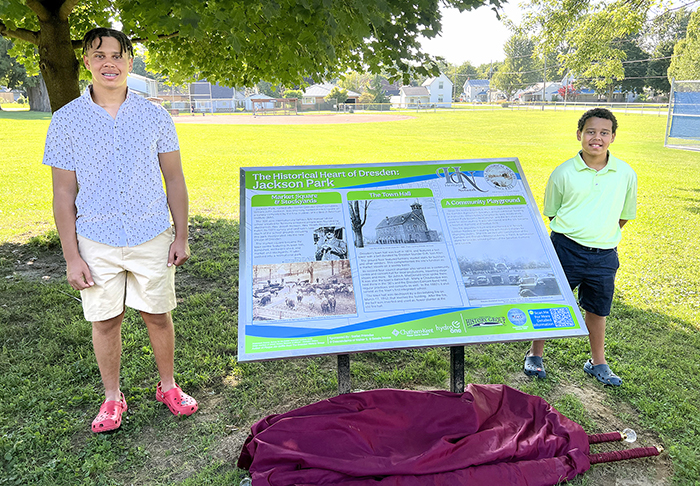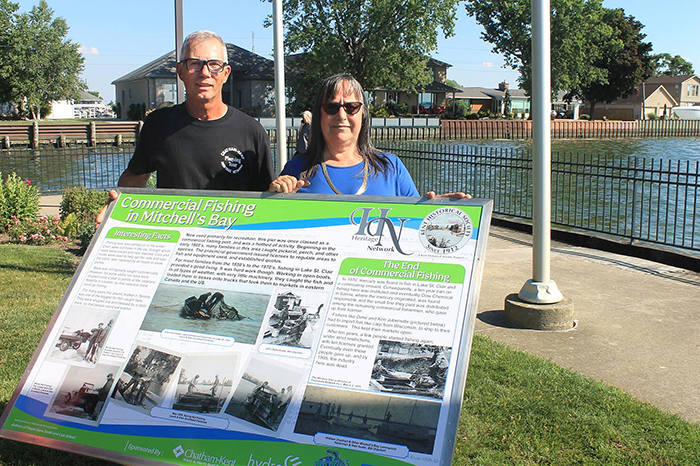
By Pam Wright
Local Journalism Initiative Reporter
Chatham-Kent’s rich history is getting a boost thanks to a commemorative plaquing initiative that reaches all corners of the municipality.
The program, a collaboration between the Chatham-Kent Heritage Network, the Kent Historical Society and the municipality, is installing 12 large, colourful plaques marking a range of significant events and individuals.
Officially installed Aug. 7, a plaque at Dresden’s Jackson Park is the latest to take shape. It honours the site that’s been dubbed the “historical heart of Dresden,” paying homage to the land that between 1871 to the 1950s once housed an impressive two-storey brick town hall, a market square, cattle stockyards, a bandshell, fairgrounds and more.
The land for the park was originally acquired from the British American Institute, a school for formerly enslaved people founded by abolitionist Rev. Josiah Henson, Rev. Hiram Wilson and J.C. Fuller. The school had 300 acres at the time and officials were unable to use it all, prompting the sale of a portion.
Jackson Park is named after Dresden Chief Const. William John Jackson who lived in a home across the street. He was noted for taking care of the grass and flowerbeds.
Today, Jackson Park is a well-tended green space featuring a playground, a baseball diamond and a pickleball court. It continues to play a central role in the community, used as a gathering place for events such as the Dresden Night Market.
According to Lisa Gilbert, C-K Heritage Network chair and president of the Kent Historical Society, the commemorative plaque idea has been in the works among local history buffs for a long time. However, the idea finally came together in 2022. The municipality received onboard contributing cash from C-K’s Hydro One Community Fund. Individuals and businesses also stepped up to donate towards the cost of each individual plaque, valued at around $2,000 each.
Networking took place, a nomination process was held, and 12 sites were selected by a committee.
Gilbert said the plaques, each containing a QR code, are an important tool to raise awareness about the significance of local history.
“Plaques are a very public way for everybody to learn about their local heritage,” Gilbert explained. “Local history is by far the most significant and important part of history. It involves names, people and places that we pass by every day.”
Plus, she said, the plaquing effort has brought together historians from around the municipality, creating a shared network where people work together.
“Chatham-Kent is a very large municipality,” Gilbert said, noting the plaque project helps local residents learn about their collective past.
“It’s beneficial to everyone,” she added.
A total of nine plaques are already in place, including:
- The first in Chatham’s Stirling Park honours the storied Chatham Coloured All-Stars. Sponsored by the descendants of team members, the plaque tells the courageous story of the all-Black baseball team, that in 1934 broke barriers by facing down racism to claim an all-Ontario provincial baseball championship.
- A plaque has also been erected in Thamesville in honour of the Ferguson Opera House. Built by the prominent Ferguson family, the 400-seat theatre drew top-notch talent to the area. It was damaged by a fire in the 1950s and torn down in the 1960s.
- The former Craford Settlement, located near Morpeth, has also been commemorated. Dating back to the War of 1812, American soldiers were captured by the British at the site when they went to look for cattle. The incident took place in 1813 during the Battle of the Thames following a skirmish at McCrae House where the Americans were attacked by the British.
- A plaque at Erieau, recognizing the important role tourism has played in the community, has also been erected. Then, as now, Erieau was known as a bustling summer resort village. In the past it was the southerly hub of the Erie and Huron Railroad that was built in 1886. The railway brought scores of travellers to the town.
- The 1854 Baptiste Creek train disaster has also been marked. Located close to present day Jeanette’s Creek, the crisis killed 57 people and injured more than 100. Even though the train accident occurred some 170 years ago, it is still listed as one of the top 10 railway disasters in Canadian history.
- A plaque at Mitchell’s Bay to honour the community’s once flourishing commercial fishery has also been installed. Formerly a mainstay of the Bay, the industry went into decline in the 1970s following a mercury contamination scare. It never fully recovered.
- A plaque acknowledging the significance of the glass industry to the community of Wallaceburg has also been installed. Starting out as Sydenham Glass in 1884, the factory was the town’s main economic driver for more than a century before closing in 1999. At its peak it employed 1,400 workers. Around 500 people lost their jobs when the doors shut and the business was moved to the United States and Mexico.
- A trio of prominent Merlin families have been recognized by a plaque in this West Kent hamlet. The founding families, central to the settlement’s development, include the surnames Smith, Marshall and Dent.
Three additional plaques have yet to be installed under the current initiative. Blenheim’s historical municipal buildings on Talbot Street, that were torn down in the 1950, will be commemorated.
- A plaque will also be erected in Highgate to commemorate the famous find of an intact Mastodon skeleton on a local farm in 1890. Following a tale with many twists and turns, the skeleton is now housed at the University of North Dakota.
The final plaque in the series will acknowledge Abraham Iredell, an early surveyor who surveyed Chatham in 1796. Iredell moved to the settlement with his family in 1797.
Businesses or individuals who wish to donate to the plaquing effort can contact lgilbert@ciaccess.com online or call 519-674-2322.







